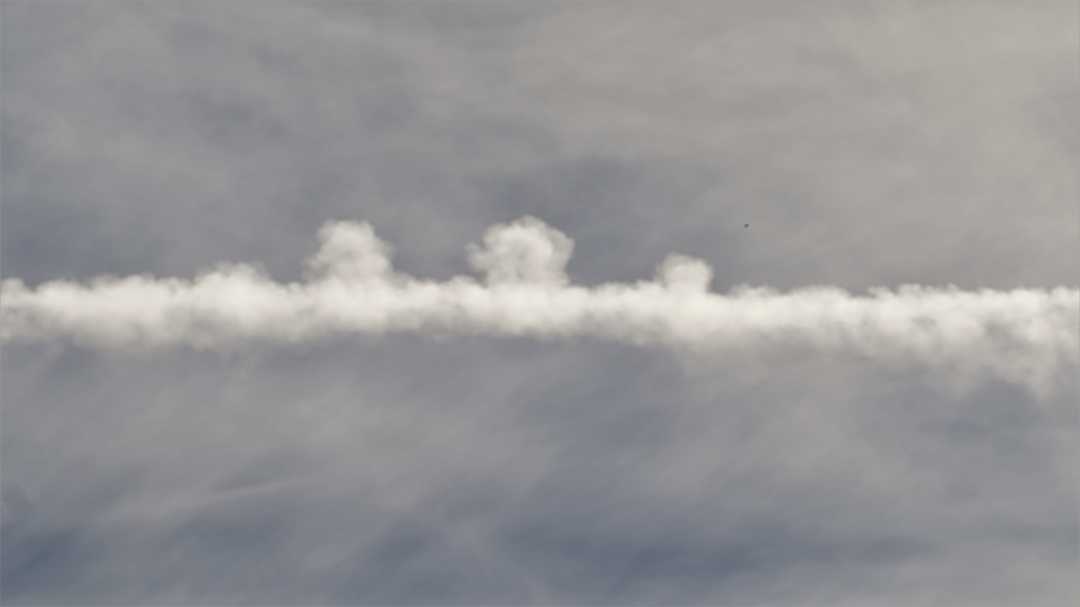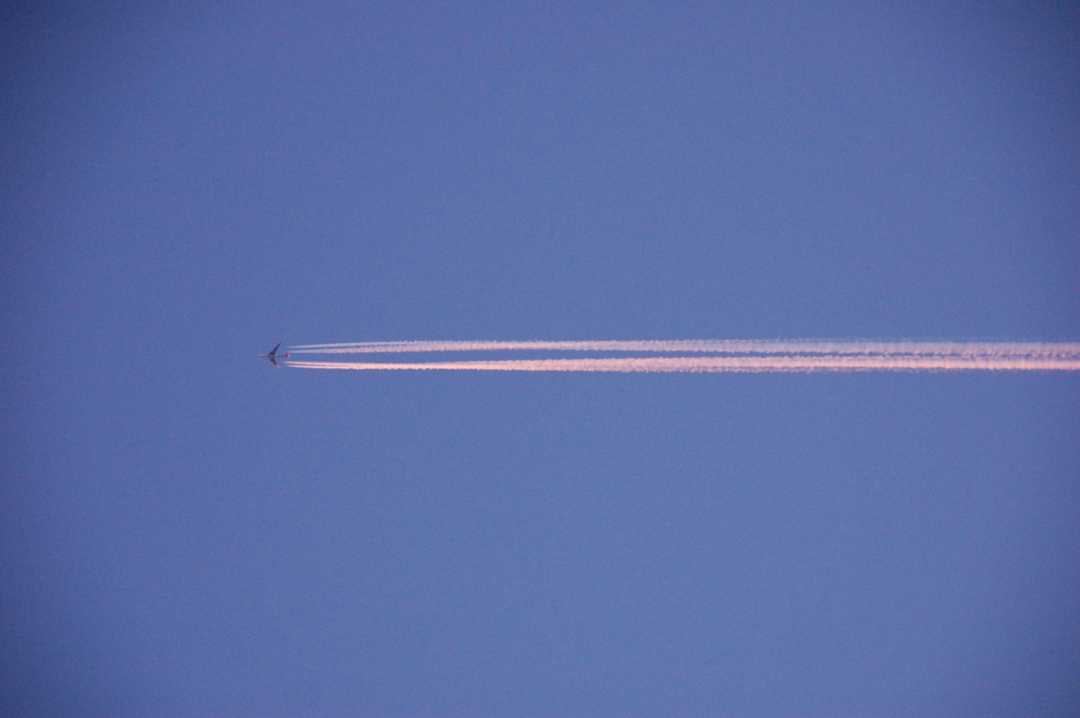Castellanus on top of a contrail?
Forums › The Cloud Forum › Castellanus on top of a contrail?
- This topic has 14 replies, 5 voices, and was last updated 8 years, 1 month ago by
Alec Jones.
-
AuthorPosts
-
-
November 5, 2017 at 10:00 pm #239051
 George PreoteasaParticipant
George PreoteasaParticipantLooking for something to shoot with my new telephoto lens …

-
November 6, 2017 at 11:36 pm #239201
Howard Brown
ParticipantRather cute, George. I am not sure about ‘castellanus’, but they certainly have a crenellated or turreted look. The old ICA talks of ‘pendant swellings like inverted mushrooms’. But yours are not inverted.
Your next challenge, should you choose to accept, might be the eddies from propeller- and wing-tips.
-
November 7, 2017 at 12:15 pm #239273
 George PreoteasaParticipant
George PreoteasaParticipantHygge,
About castellanus … I was reading this in the Cloud Atlas:
https://cloudatlas.wmo.int/species-cirrocumulus-castellanus-cc-cas.html
So if you can have castellanus on top if cirrocumulus, why not on top of a contrail?
-
November 7, 2017 at 11:54 pm #239361
Howard Brown
ParticipantGeorge, castellanus is a species within four genera. Contrails, while recognised, are not to my knowledge a formal cloud type. Hence when discussing (young) contrails I feel one should not use formal terminology; if the contrail matures it can transmogrify (you might find a better word) into a formal cloud type with appropriate terminology.
But it’s not for me to say what you can or can not have. Glad you seem to have an enquiring mind and enjoying it.
-
-
November 13, 2017 at 1:19 am #240135
 George PreoteasaParticipant
George PreoteasaParticipantNow I am a bit obsessed. Doing some google research, I find references to lobes or pendules, but all references are to things hanging down. Among others, I found a serious article:
http://onlinelibrary.wiley.com/doi/10.1002/wea.2765/full
which, interestingly, shows a picture of contrails exhibiting the same upward lobes, but does not mention them (maybe it does at some point, I did not read the whole article, TBH). (Do look at the link above, the picture is of WWII fighter plane contrails, quite unusual.)
So here is my shot of today with upward lobes. There is a certain regularity, which makes me think this may be a turbulence effect, rather than thermal (convection).
Finally, while doing this search, I found what appears to be a Thai Airlines commercial showing some nice contrail iridescence:
Hope you enjoy it.

-
November 13, 2017 at 11:20 am #240183
 Hans StockerParticipant
Hans StockerParticipantI do enjoy this George. Interesting article you found on the subject of lobes or mamma. Conclusion: lobes. Do you remember the Cloud of the Month for November 2016? The accompanying explanation is all about the lobes (although downwards).
For the upward lobes I am not yet convinced whether it might be a matter of perspective. Up or down is sometimes hard to distinguish from where we are watching. On the other hand upward convection and flows must be possible somehow imho.
There is a lot of contrail over here and I will look for upward lobes from now on.
-
November 13, 2017 at 11:50 pm #240276
Howard Brown
ParticipantGood work, George. Much to chew over. I wonder if the article will be updated in light of the new ICA (see first sticky thread in this forum).
I would concur with the importance of correct terminology. So you might be on a winner George, but did not get the right words (and might have to wait ten minutes):
https://cloudatlas.wmo.int/explanatory-remarks-and-special-clouds-cirrus.html
-
November 14, 2017 at 8:16 pm #240396
Nigel Okey
ParticipantGeorge,
The online paper you found in the journal Weather has contact details for the authors. I Googled Schultz, and I found that he’s still at Manchester University:
https://www.research.manchester.ac.uk/portal/david.schultz.html.
I think it would be worth contacting him, sharing your photo with him, and asking for his view on how your upward features were formed – his paper deals with below and sideways formation, but not upwards.
Let us know what the outcome is – we are all interested.
Note that the picture with ‘upward’ lobes that you mention (his Fig. 6, I think) is of Kelvin-Helmholtz, which are not the same at all, but are still very interesting. I love K-H formations, which are relatively rare.
I have a question about ‘your’ contrail – what was its behaviour to the left and right of the area of your photo?
Plus, I think we all need to keep our eyes open and start to make notes of any contrails we see that develop this feature, whether up or down. This will provide a good statistical data-set so that we can understand how rare are the upward formations, and if the direction can change along a contrail. A fun bit of “Citizen Science”.
Regards,
Doctor_NO.
-
November 14, 2017 at 11:08 pm #240436
Howard Brown
ParticipantWell I never, Dr NO. You are familiar with the CAS Old Forum
so you will remember the school teacher in Lancashire, UK, who collected contrail pictures. I don’t think it was confined to a single thread. So a text search on ‘contrail’ should throw up some pictures. He also had his own website, may have offered it to the old forum, and some forum photographers e.g. Andrew Kirk also contributed directly to that website. On the old forum contributors could offer their e-mail address if they wished, in their log in data (or whatever), so you might find that.
Lastly the teacher may have been the one to snap the very rare supernumerary rainbow, or was it a higher order bow, and I think we lost him around there (but my memory may be playing tricks).
-
November 18, 2017 at 11:46 pm #241299
Howard Brown
ParticipantThe teacher was Alec Jones, probably of Bolton, Lancs – I have asked the Bolton Grammar School (which is now renamed) if he is on their staff. I think we lost Alec because he was simply unable to log on to the old forum, a Network54 problem I suffered from too for some while. His blog from 5 years back seems to have disappeared.
-
-
November 24, 2017 at 11:25 pm #242409
Howard Brown
ParticipantI struck lucky and was able to contact Alec who kindly replied – his contrail blog has gone. See also the Halo vault topic.
-
November 24, 2017 at 11:49 pm #242414
Howard Brown
ParticipantI take heed of Hans’ warning – up/down or left/right can be tricky. This intrigued me because the colours of the trails are slightly different. George, you must have quite a lens there.

-
November 25, 2017 at 2:55 am #242440
 George PreoteasaParticipant
George PreoteasaParticipantHygge, I have a zoom that goes to 300 mm focal distance, though (I am told) for the sensor in my camera, it is actually a 450 mm.
WRT up/down, both shots I posted were looking up at no more than 45 degrees. Hard to believe those lobes had no significant upward component. Hygge, from the way the airplane looks, your shot could be almost looking 90 degrees up.
-
December 9, 2017 at 4:35 am #245648
 George PreoteasaParticipant
George PreoteasaParticipantMe again with the upward lobes. Not as clear (and partly because of my poor focusing skills) but I think the upward tendency is there. I’m aiming 30-40 degrees above the horizontal.

-
December 9, 2017 at 1:10 pm #245709
Alec Jones
ParticipantThis effect is observed extremely frequently by those who take an active interest in contrails. Whether it can be likened to castellanus or not is a moot point. All I would say on the matter is that many of the large scale atmospheric variables which act upon and help to form certain types of clouds also have an effect on a smaller scale on contrails. So who knows?!
I remember discussing the possibility of introducing a classification of contrails many moons ago. Perhaps it would be useful and opportune to re-open that discussion once more?
-
-
AuthorPosts
- You must be logged in to reply to this topic.






